Missed opportunities Brusilovsky breakthrough
11 Army General Sakharov launched an offensive on May 22 (June 4) after the 8-hour artillery preparation, the shortest at the front. The 11 Army had 8,5 infantry and 1 cavalry divisions, about 150 thousand soldiers and 382 guns. The enemy had superiority in forces - 9 full-blooded infantry and 2,5 cavalry divisions, a total of 157 thousand soldiers and 614 guns, as part of the 1 and 2 of the Austro-Hungarian armies and the left flank of the South German army.
In the center of the attack, General Hutor's 6 Corps fell on the strongest place of the enemy front - the reinforced left-flank 9 Corps of the South German Army. In the bitter battles of 22-27 in May, our troops suffered serious losses and did not succeed. The 6 body lost half of its membership. But on the right flank of the army, units of the 17 corps of General Yakovlev unexpectedly managed to break through the positions of Austrians at the junction of 1 and 2 of the Austro-Hungarian armies in the area of Kopanov, take three lines of trenches, capturing dozens of officers and more than 2 thousand soldiers . The army reserve was transferred to this area - the Zaamur cavalry division, but it did not have time to enter the breakthrough and the enemy managed to take out the artillery. May 24 (June 6), the enemy pulled up reserves for this section and launched a counterattack. Our troops repulsed the frenzied attacks of two divisions of the left flank of the army of Böhm-Yermoli.
General Sakharov, seeing the failure of his main attack and the success of the 17 Corps, decided to pay attention to his right flank. The 29 of May included the 11 and 32 corps, which had just defeated the 45 of the Austro-Hungarian army in the battle of the Ikve and Dubno rivers. However, Sakharov held them and began to "align" the body. Thus, Sakharov, like his neighbor Kaledin and Brusilov’s com-front, did not realize the full significance of the victory and complained about the “too rapid advance” of the 1 army. As a result, the front headquarters transferred the 8 army to the left-flank corps of the 11 army.
The 7 Army I Shcherbacheva launched the 24 offensive in May (June 6) after the 45-hour artillery preparation, the longest of all the front armies. Such a long-term artillery preparation was due to the fact that our troops had to crush the strongest part of the enemy front (the Germans considered the positions of Yazlovets to be impregnable and the standard of defense) if the enemy had more than double superiority in artillery. The 7 Army had 7 infantry and 3 cavalry divisions, all 143 thousand soldiers with 326 guns. Against our troops stood the South German army - 9 infantry and 1 cavalry divisions, all 138 thousand people with 710 guns.
In the direction of the main strike, 2 Corps of General Flug, together with the Turkestan Division, on the very first day broke through the 2-3 lines of the enemy's trenches. May 25 (June 7) Our troops on the shoulders of the enemy broke into Yazlovets. 25 May attacked the central 16 corps of General Savvich and knocked over the 6 Austrian-Hungarian corps. May 27 launched the offensive right-wing 22 Corps of Brinken and smashed Hoffmann's enemy corps. Austrian troops, suffering heavy losses, retreated in disarray across the river Strypu. The army of the Shcherbachev army forced Stryp in all three corps.
In the morning of May 26 (June 8) a reserve was introduced into the breakthrough - the 2 Cavalry Corps. The 9 Cavalry Division became famous for the heroic attack of the strongly fortified position of the enemy at Porkhov. This attack completed the rout of the 13 of the enemy corps. The 2 Austrian-Hungarian cavalry division, which was fighting on foot, was practically cut down by Russian cavalrymen.
From May 28 (June 10), the enemy, taking advantage of the extended position of the 16 corps, launched a strong attack on his bare right flank at Buchach. Our 41 Infantry Division suffered heavy casualties and retreated. In further battles, Shcherbachev’s army repulsed the enemy’s counterstrike. By 4 (17) of June, the position in the 4 Army was completely stabilized, the enemy’s counterattack was repulsed. However, General Shcherbachev decided to stop the further offensive, fearing to make a deep breakthrough with such small forces.
On the left wing of the South-Western Front, the troops of the 9 Army of Lechitsky on the very first day broke through the first fortified band of the enemy. In the 9 Army, there were 10 infantry and 4 cavalry divisions, altogether about 180 thousand soldiers with 489 guns. She was confronted by the 7-I Austro-Hungarian army of General Pflanzer Baltyn - 7 infantry and 4,5 cavalry divisions, only about 130 thousand people and 548 guns. Lechitsky poured in the 12 Corps, temporarily without a commander, in Barantsev's 11 Corps, bringing its composition to the 4 divisions. The reinforced 11 corps delivered the main attack on the left flank of the army on Chernivtsi direction. The 41 Corps on the central direction contributed to the main attack by the attack on Onut.
May 22 (June 4) Our troops had success, breaking through the first line of enemy defenses. But on May 23-24 (June 5-6) the advance was stalled. The enemy put up stubborn resistance, relying on strong defensive positions. In these battles, the 3-I Zaamur division, which took Onut and Window, was especially notable. Then Lechitsky halted the offensive and regrouped his forces and continued the attack on 28 in May (10 in June), introducing the 33 corps into battle. In the battle of Dobronouc, the 7-I Austro-Hungarian army was literally torn to pieces and torn in half. One group of Austro-Hungarian troops was driven back south to Prut, the other west, in Transdniestria. The enemy lost up to 70 thousand people, our losses - about 14 thousand soldiers.
Thus, at the beginning of the offensive, the South-Western Front achieved major success. It was especially significant in the band of the 8 Army, although the army’s right flank, the 46 and 4 Cavalry Corps, did not fulfill its task. But in the direction of the main attack, the enemy positions were broken through at the width of 70-80-km and in depth at 25-35 km. The enemy suffered serious losses, only about 1 thousand were taken by prisoners by the end of 150 June.
The 4 th Austro-Hungarian army of Archduke Joseph Ferdinand in Volyn and the 7 th Austro-Hungarian army Pflanzer Baltina in Bukovina suffered a crushing defeat, losing most of their combat forces. The 1, 2, and South German armies were very shocked. And this is just one week! That is, the main enemy forces in the southern strategic direction were defeated or suffered defeat. Lutsk breakthrough could lead to a complete and brilliant victory. However, as we remember, the South-Western Front was only to "demonstrate", to produce an auxiliary attack in order to support the Western Front. Brusilov did not have a second echelon of the development of the offensive and reserves, which would finally crush the enemy before the approach of his reserves and troops from other directions.
In other conditions, the breakthrough of the enemy’s defenses needed to be immediately developed, to act like Suvorov — to disperse and crush the cracked enemy armies and with lightning strikes of the 8 and 11 armies from Lutsk and Sopanov on the Russian Rava — to the flank and rear of the entire enemy group, to withdraw from building a shocked Austro-Hungarian army, to separate the German and Austrian parts of the front, and then withdraw the Austro-Hungarian army from the war. However, unfortunately, there was no commander of the Suvorov school in the Russian General Headquarters.
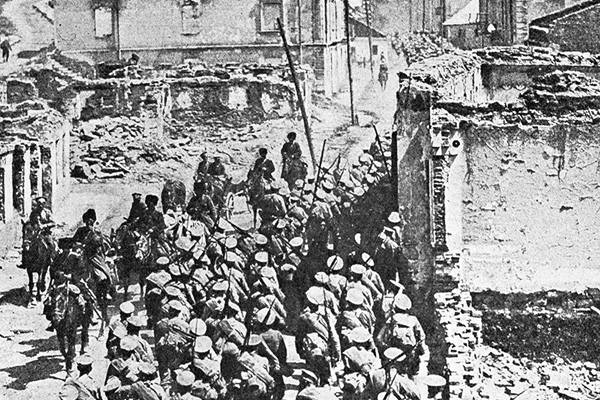
Russian troops in Buchach
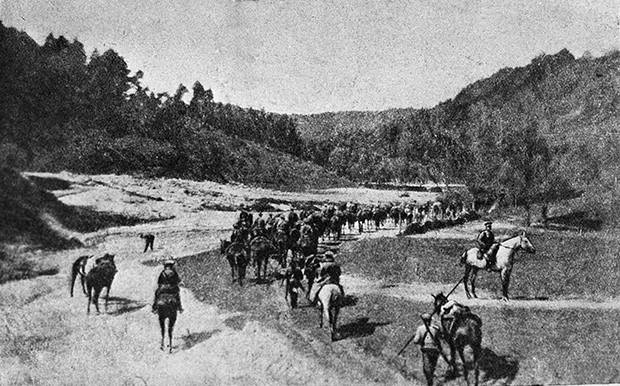
Russian offensive in June 1916
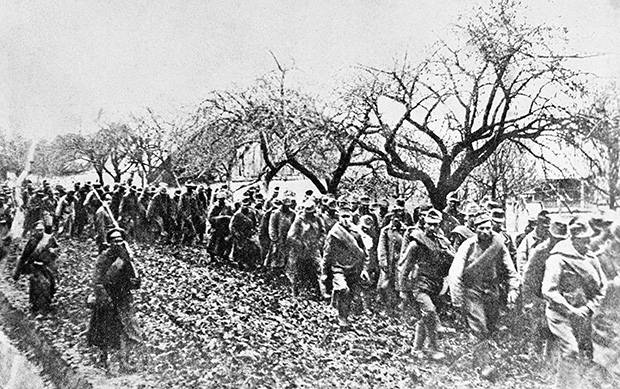
Austrian prisoners
Russian command
May 26 (June 8) Brusilov issued a directive according to which the 8 Army, having firmly established itself at the turn of the Styr River, was to develop an offensive on the flanks of the attack force. The cavalry was instructed to break through to the rear of the enemy grouping. 11-I, 7-I and 9-I armies were supposed to perform the same tasks. Brusilov assumed that 28 of May (10 of June), with the approach of the 5 of the Siberian Corps, would launch an offensive with an exit to the line of Kovel, Vladimir-Volynsky, Sokal. In the meantime, they planned to expand the breakthrough towards the flanks, mainly to the south-west, in order to alleviate the situation of the 11 Army, which at that time was waging heavy battles with large enemy forces.
The situation strongly demanded that the main attack be transferred from the Western Front to the South-Western, but the Stavka did not do this. May 27 (June 9) was given a directive Alekseeva, which put the South-Western Front to continue to hold down the enemy with battle and concentrate all efforts on the right flank, complete the defeat of the left wing of the Austrian army, cutting off her path to the Sana. At the same time, the Western Front was allowed to postpone the strike until 4 (17) of June. True, the Western Front was supposed to support the actions of Brusilov’s armies by delivering an auxiliary strike with the 31 Corps of the 3 Army, which was defending on the left wing of the Western Front. 3-I army had to take Pinsk, and then prepare to strike at Kobrin and Brest. The 31 Corps was to launch an attack before the entire front of Evert, 31 May. The northern front was instructed to prepare the dispatch of another corps to the South-Western Front.
The proposals of the Bet have aroused great objections from Brusilov. On May 28 (June 10), he sent a telegram to Alekseyev, where he noted that it was dangerous to push the right flank of the front (8 Army) forward, as there would be a strong gap between the South-Western and Western fronts, which the enemy could take to the flank and rear of the Russian troops. At that time, the Austro-German command was sending considerable reinforcements and reserves to the area of the breakthrough. Brusilov proposed until 31 May, that is, before the 3 Army of the Western Front went on the offensive, to develop the offensive by the flanks of the 8 Army and ease the position of the 11 Army, while remaining centered in the center, sending only cavalry forward. 9-I, 7-I and 11-I armies were supposed to perform previously assigned tasks.
30 May Alekseev agreed with the proposals of Brusilov and gave instructions to strike at Rava-Russkaya. However, he did it in his style of advice and persuasion, that is, the headquarters of the South-Western Front could accept the instructions of the Stake "to note", nothing more. Thus, the headquarters of the Supreme Commander did not guess to transfer the center of the offensive to the southern strategic direction, the main attack remained behind the Western Front. The South-Western Front did not have the forces and means to develop an independent broad operation. Brusilov could only deliver an auxiliary blow to Kovel. This allowed Austria-Hungary to save their army for the second time from total annihilation (the first was during the 1914 campaign of the year).
31 August (13 June) Brusilov issued a directive, according to which the front armies should have been 1 (14) June should have continued the offensive in order to complete the rout of the enemy. The main role, as before, was assigned to the 8 Army. She was given the task of reaching the line of Kovel, Vladimir-Volynsky, Poritsk. This was supposed to create conditions for the development of an offensive against Rava-Ruska. The headquarters of the South-Western Front gave great hopes to the offensive of the Western Front, especially its left-flank 3 Army. However, this time the concerted actions of the Western and Southwestern Front were thwarted due to Evert's fault. Referring to the possibility (!) Of rainy weather and the incompleteness of the concentration of the 27 division with a heavy battery, he ordered the commander of the 3 army to postpone the attack on the Pinsk direction until June 4 (17). Alekseev once again agreed with the postponement of the offensive of the Western Front.
It was only at the beginning of June that the Russian Headquarters realized the need to use the success of the South-Western Front. 3 (16) June was issued a new directive. The offensive on the Vilnius direction, which was to begin on June 4 (17), was canceled. The Western Front was assigned the task no later than 12-16 of days to deliver the main attack from the Baranavichy area on the Novogrudok and Slonim section in order to reach the Lida, Grodno line. At the same time, the left flank of the Western Front was to seize the Pinsk region and develop an offensive on Kobrin. The northern front was supposed to improve its position and hold down the enemy. The immediate task of the South-Western Front was an attack on Kovel. At the same time, the troops of the front had to secure their left flank and prepare the continuation of the offensive for the capture of the frontiers of the Sana and Dniester rivers. In this new operation, the front also had to deliver the main attack with the right wing, in order to cut off the enemy from Sana and, if possible, separate the Austrian and German armies. Brusilov’s front was planned to be reinforced with two corps and two heavy artillery divisions from the Western and Northern fronts.
In a conversation with Alekseev on the direct wire 4 (17) of June and in a telegram from 5 (18), Brusilov noted a number of negative aspects of the changes in the original plans. The refusal of the offensive of the Western Front 4 (17) in June, as well as the initial delay, put the South-Western Front in a difficult position, exposing to the blow of reinforcements and reserves of the enemy. A large enemy group has already concentrated in the Kovel area, another group has already acted on the part of Vladimir-Volyn. The forces of the front were not enough to withstand the new forces of the enemy, and the arrival of two new corps was delayed. In addition, the new postponement of the offensive of the Western Front undermined the morale of the troops of the South-Western Front, who were expecting support from other Russian Front forces. A difficult situation with ammunition. For two weeks of heavy fighting, the ammunition was consumed; only light shells remained. Suitable fresh enemy troops had nothing to hold back. Therefore, Brusilov insistently asked to send ammunition from the Northern and partly Western Front. “In any case,” he wrote, “it would be cruel to remain without rifle cartridges, and this would threaten with catastrophe. While supplies are abundant, there is still hope that we will be beaten off, and then it will be impossible to dream of such hope. ”
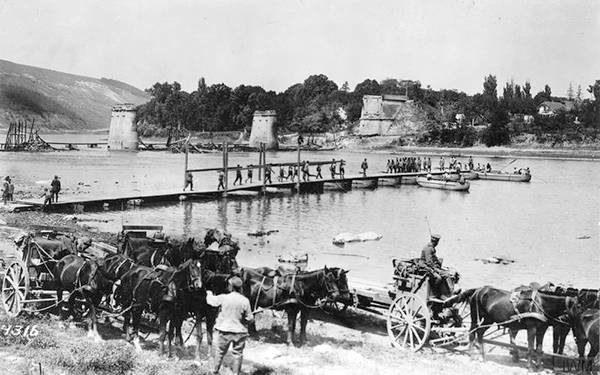
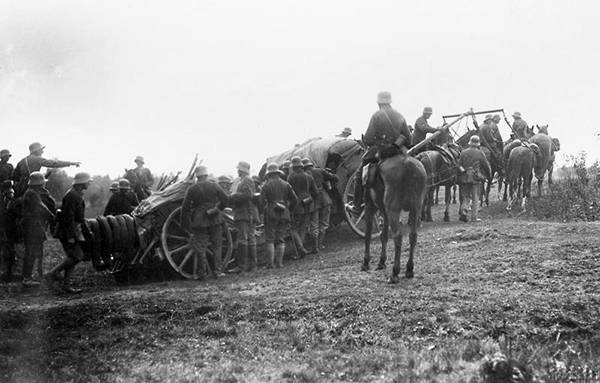
German troops on the Eastern Front
Enemy actions
Brusilov's concern was well-founded, since the enemy did not sit with folded arms. The situation in the southern strategic direction began to deteriorate. Very soon the forces of Brusilov had to withstand the powerful onslaught of the fresh forces of the enemy. Unlike the Russian high command, the Germans reacted very quickly to the defeat of the Austro-German troops in the Lutsk area.
At first, the Austro-German command did not attach particular importance to the offensive of the South-Western Front, believing correctly that it was only demonstrative (as it was according to Russian plans) and distracts attention from the Russian Western Front. However, the Lutsk breakthrough forced the Austro-German command to change this opinion. Of particular concern was the possibility of losing Kovel, a large communications hub in the area. The departure of Brusilov’s troops into this area could have affected the stability of the German front north of Pripyat. The Russian army showed amazing stamina and the preservation of offensive power, which for some German generals, after the success of the 1915 campaign of the year, was quite surprising. The chief of the German General Staff, Erich von Falkenhayn, was forced to telegraph Kaiser Wilhelm II: "We did not pay enough attention to the preparation of the Russian offensive in the Carpathians - now there is every reason to believe that the fate of the Austrian front in the east will be resolved within 7-10 days."
May 26 (June 8) in Berlin held a meeting of the chiefs of staffs of the general staffs of the Central Powers. It was decided to concentrate the attack group in the area of Kovel under the general command of Linsingen in order to seize the strategic initiative from the Russians and stop the offensive of the Brusilov front. From the Western Front, the Lutvitsa 10 Army Corps, consisting of the 19 and 20 Infantry Divisions, and the 29 and 61 Infantry Divisions, as well as various formations from the Eastern Front, began to be deployed to the Kovel area from the Western Front. The Kovel's breach was gradually filled with various troops, who collected almost battalion from various places of the Russian front. Thus, the enemy command, faster than the Russian Headquarters, realized the full danger of the Lutsk breakthrough and quickly responded, sending troops from where it was possible.
3 (16) June Austro-German troops launched a counterstrike. The Austro-German command planned, through a concentric offensive in the general direction of Lutsk, to eliminate the breakthrough of the Russian troops and to throw away the Brusilov armies to their original positions. The troops of the 8 Army and the right flank of the 11 Army were forced to repel the strong onslaught of the enemy. The counter-strike of the Austro-Hungarian troops did not succeed. The fierce resistance of the Russian troops disrupted the plans of the enemy. It should be noted that if the Western Front had launched a decisive offensive in the previously scheduled time, the German command would not have been able to divert significant forces from other sectors of the Russian Front.
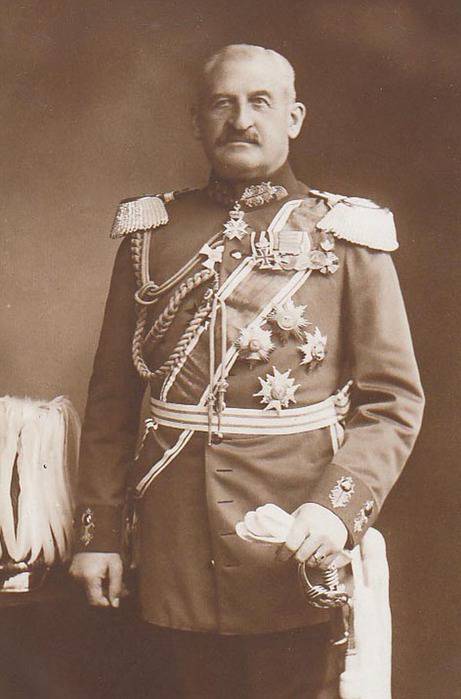
General Alexander von Linsingen
Further offensive of the troops of the South-Western Front
By 1 (14) of June, fierce and successful battles continued for our troops on the entire front of the South-Western Front. True, a convenient moment for the development of the Lutsk breakthrough was already missed. The South-Western Front did not have enough determination and strength to continue the decisive attack on the orders of the enemy. And the enemy hastily threw new troops into the area of the breakthrough and grew stronger with each passing hour. 10 of the German corps was thrown onto the Waves, which became the nucleus of a new enemy force and restored the front. The Austro-German Command formed the group of General von Berngardi, which reinforced the left flank of the 4 of the Austro-Hungarian Army in the Kovel direction, the von Marwitz group - which strengthened the center of the 4 Army, the group of General Falkengain - strengthened the right flank of the 4 Army and the left flank 1 st army. 8 German divisions had already deployed Brusilov to the front, 8 divisions were expected in the near future and 8 of Austro-Hungarian divisions were being transferred from the Italian front to Galicia.
2 (15) June Bernhardi's troops repelled the impact of the 5 Siberian Corps at Poritsk. From 3 (16) of June, the forces of Kaledin's 8 Army were forced to repel the violent attacks of the Austrian-German divisions of the Linsingen group by the 18 (for the most part in the fresh divisions). The stubborn defensive battle in the Kisselin area continued for 8 days. On the right flank, our 46 and 30 corps repelled the attacks of the troops of Gower, Fata and the 2 Corps of the Austro-Hungarian Corps from the 4 Army. In the center, on the Stokhod River, the 5 Siberian and 39 Army Corps fought against the troops of the Bernhardi and von der Marwitz groups, the 40 Corps threw off the two corps of the Austro-German Army 4. Violent battles were fought at the junction of the 8 and 11 of the Russian armies, where the left flank of Kaledin’s army and the right flank of Sakharov’s army held back the frenzied onslaught of the Falkengain group.
Kaledin has already begun to fear that he will be cut off and destroyed. Brusilov sent to the 8 Army the newly arrived 23 Corps, which strengthened the position in the center of the Kaledin Army. The 1 Army Corps, which was on its way, was supposed to replace the 5 Siberian Corps exhausted by the battles at Stokhod. By 10 (23) of June, the position of the 8 Army was stable. Both sides in these fierce battles lost thousands of people on 35-40.
While Kaledin's regiments were repelling the onslaught of the Linzingen group in the Kiselinsky battle, three other armies of Brusilov continued the offensive. Sakharov's 11 Army delivered a heavy blow to the 1 and 2 Austrian-Hungarian armies, Puhallo and Böhm-Hermoli, hitting their joint with its center. 2 (15) June 32 Corps in a fierce battle captured Berestechko, pursuing the enemy Zaamursky cavalry division on the shoulders of the defeated 18 of the enemy corps broke into the Radziwills. Meanwhile, the 17 Corps captured Pochayev and Pochayev Lavra, pushing the left flank of the 2 of the Austro-Hungarian Army beyond the border line. Our troops won in the battle of Berestechko. Then the left-flank 7 body took possession of the Black Forest. And the right flank of the 11 Army took part in the heavy battles of Kisselin.
The 7 Army, which departed the left flank of the 11 Army - 18 and 6 Corps, reflected with its center (22 and 16 corps) the attack of the group of the Bothmer army and with a series of short blows defeated the South German army. The 9 Army developed its success in the Dobronouc battle, smashing the frustrated forces of the Pflanzer 7 Austro-Hungarian Army. 4 (17) June, our troops crossed the Prut. 5 (18) June The 11 corps quickly occupied Chernivtsi, turned by the Austrians into a well-fortified fortress and named for its supposedly inaccessibility “second Verdun”.
Then General Lechitsky stopped his strike group (41, 12 and 11 corps) on the Prut line, intending to turn the troops to another operational direction - Kolomea and Stanislavov. Only the Consolidated Corps of General Promtov and the 7 Cavalry Corps of Count Keller were sent to pursue the fleeing southern group of the 3 Army. 10 (23) June Promtov's troops occupied Suceava, Keller - Kimpolung.
It was a great success. However, the premature stop of the army strike group on Prut, the weakness of the Consolidated Corps and the late use of Keller's cavalry led to the fact that the defeated enemy could not be cut off from the Carpathians, but only pushed aside to the mountains, where the Austrians entrenched on powerful lines. By 12 (25) June at the front there was a lull, the fighting continued only in certain areas.
In the meantime, the altercations of the South-Western, Western fronts and the headquarters headquarters continued. Evert still did not dare to attack, asking for a delay for a delay. Brusilov rightly complained about Evert's inaction, asking the headquarters to speed up the offensive of the Western Front. Alekseev agreed with one and then with another. Directives rates were vague and unclear. The South-Western and Western fronts began to lay claim to the 3 Army Lesha. By stopping, she was to join the Brusilov front. And Alekseev at first agreed with Evert, and then Brusilov, to whom in the end 10 (23) of June transferred the army. However, Evert had time to take the 3 corps from 4 from the 5 army, Brusilov got only the army headquarters and one 31 corps. Brusilov had to give the 3 Army the right flank of the 8 Army - the 46 and 4 Cavalry Corps.
The headquarters sent to the South-Western Front, in addition to the already arrived 1 and 23 corps, another 5 army and 1 Turkestan corps. General Brusilov was going to regroup and strike the 3 and 8 armies on Kovel. The offensive along the whole front was halted, except for the 9 Army, which continued the offensive against Stanislav-Galich.
Thus, the South-Western Front and the General Headquarters could not fully exploit the Lutsk breakthrough. When the high command began to reinforce the front of Brusilov with fresh troops, these corps had to be used to contain the counterattacks of the new troops of the enemy, which in due time reinforced the already disintegrating Austro-German front. A new attack on Kovel could not bring decisive success, since the enemy was ready. The Russian Western Front has been inactive all this time. The headquarters could not organize a decisive and simultaneous offensive by all the forces of the Russian Front.
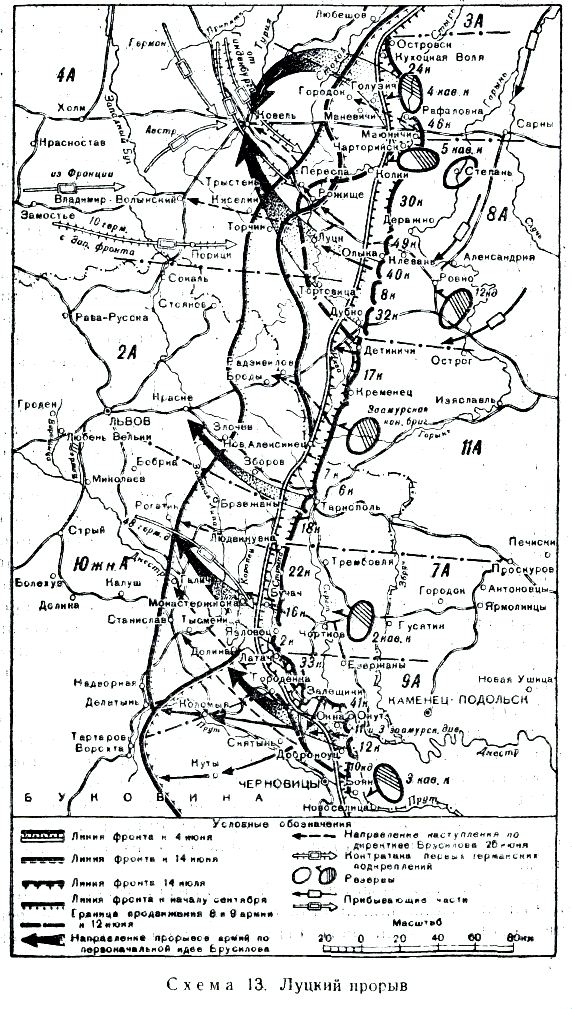
Map source: Brusilov A.A. Memories
Information